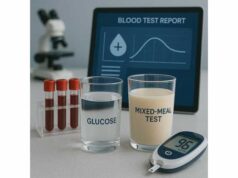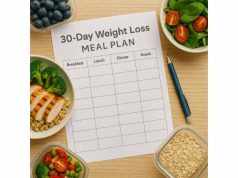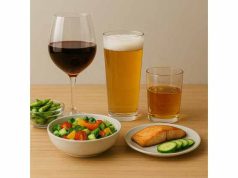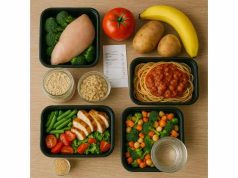
A calorie deficit works when it is small enough to live with and consistent enough to add up. The sticking point is hunger: if meals feel skimpy, you will white-knuckle weekdays and rebound on weekends. This guide shows you how to create a sustainable deficit, structure meals that keep you full, and troubleshoot plateaus without slashing calories. If you want the bigger picture on daily targets, macro balance, and example menus, start with our primer on calories, macros and sample plans. Then come back here and use the step-by-step playbook to reduce hunger and make progress that lasts.
Table of Contents
- Calorie deficit explained
- How to set your deficit
- Reduce hunger while dieting
- Protein, fiber and meal structure
- Smart meal timing and habits
- Troubleshooting plateaus and adjustments
- Sample days and easy menus
- Frequently Asked Questions
Calorie deficit explained
A calorie deficit means you consistently eat fewer calories than you expend, so your body draws on stored energy. What trips people up is not the concept but the experience: hunger, low energy, and unpredictable weeks. The fix is a modest, repeatable gap—usually 300–500 calories per day—paired with meals built for satiety.
What a realistic deficit feels like
- You are hungry sometimes, but not constantly.
- Workouts feel doable; you may be a touch slower at the end but not dragging all day.
- You can repeat your plan on work trips and weekends without “starting over” every Monday.
Why plateaus happen even when you “eat the same”
- Your needs drop as you lose weight (smaller bodies burn fewer calories).
- Spontaneous movement (fidgeting, pacing) often falls when you diet.
- Portions drift: oils, nut butters, and “just a taste” samples push you back toward maintenance.
- Water shifts mask fat loss in the short term.
Rate of loss to aim for
Most people do well targeting 0.5–1.0% of body weight per week on average. During heavy training, slower is often better for performance and mood. If progress stalls for 3–4 weeks with consistent habits, make a small change rather than a drastic cut.
Mindset that helps
Treat this as a skills project, not a 30-day challenge. Build three to five repeatable dinners, two easy lunches, and a reliable breakfast. Layer in small routines (post-meal walks, grocery defaults) that lower friction. If you want a quick overview of safe pacing and expectations, our safe weight loss guide is a good companion.
How to set your deficit
You can set a deficit with precision or with practical guardrails. Choose the style that matches your personality and schedule.
Option A: Numbers-first (percent of calories)
- Estimate maintenance (a calculator or a two-week food log averaged out both work).
- Set a modest gap: 15–25% below maintenance (often 300–500 calories/day).
- Allocate macros to support fullness: about 30–35% protein, 20–30% fat, and the rest from carbs. This combination controls hunger well for most.
Option B: Ranges and routines
- Breakfast and lunch templates: two options each that deliver 25–40 g protein, a high-fiber carb, and vegetables or fruit.
- Dinner plate rule: ½ vegetables, ¼ lean protein, ¼ high-fiber carb, 1–2 teaspoons oil or nuts.
- Snack plan: one protein-forward option (150–250 calories) for days when meals run light.
Option C: Body-weight heuristic
- Lightly active adults often maintain near 28–32 calories per kg body weight (multiply by your weight). Subtract 300–500 for a starting target. Adjust after two weeks based on trends in weight, waist, and how clothes fit.
Safeguards
- Keep protein high (details below).
- Set a minimum intake that respects your size and activity (e.g., many active women feel better not dipping below ~1,500–1,700 calories; active men often feel best above ~1,800–2,000—individuals vary).
- Avoid “all or nothing.” A weekly average beats perfect days.
For step-by-step math and examples by body size, see our guide to choosing a clear daily calorie target.
How to adjust without overreacting
- Give each change 10–14 days.
- If progress stalls after 3–4 consistent weeks, trim 100–150 calories/day (e.g., 20–30 g carbs and/or 5–10 g fat) or add a 20–30 minute post-meal walk.
Reduce hunger while dieting
The most reliable way to stick with a deficit is to make meals feel generous. Hunger is shaped by protein, fiber, water, meal volume, and routine—not willpower.
Build fullness into every plate
- Protein first: 25–40 g per meal (Greek yogurt, eggs, chicken, turkey, fish, tofu, tempeh, beans). Protein slows digestion and preserves lean mass, which protects your metabolism while dieting.
- Fiber always: Aim for 25–38 g/day, with 8–15 g at dinner from beans, lentils, whole grains, potatoes with skin, fruit, and vegetables.
- Water and volume: Foods that hold water (soups, stews, oats, fruit, vegetables) create stretch in the stomach and curb appetite.
Quick wins that lower hunger within a week
- Preload with water: Drinking ~500 ml about 30 minutes before a main meal helps many people naturally eat less.
- Start meals with produce: A salad, broth-based soup, or a plate of crunchy vegetables with yogurt dip adds volume for minimal calories.
- Use “invisible fat” carefully: Measure oils, nut butters, and dressings. Flavor with citrus, vinegar, spices, mustard, miso, or salsa.
- Swap for volume: Replace 1 tablespoon oil (~120 calories) with a cup of vegetables or a side salad; swap refined grains for intact grains or legumes.
Smart treats
You can eat dessert and lose weight. Make it intentional and portioned: a piece of fruit and dark chocolate, a small scoop of ice cream in a ramekin, or a protein pudding. Unplanned grazing is the real issue, not treats by definition.
For a deeper list of foods and plate ideas that maximize fullness per calorie, browse our guide to high-volume, low-calorie foods.
Measure what matters
Track weekly averages for weight and waist. If evening hunger persists despite protein and fiber targets, add a 150–250 calorie protein-centric snack after dinner (Greek yogurt with berries, cottage cheese with pineapple, or edamame) and observe whether snacking calms down.
Protein, fiber and meal structure
Protein and fiber are the levers that make a deficit livable. Structure is how you pull those levers daily with minimal effort.
Protein targets that work
- Daily: 1.6–2.2 g/kg body weight for most adults.
- Per meal: 25–40 g, plus a protein-forward snack if needed.
- Easy anchors: 250 g Greek yogurt; 120–170 g chicken, turkey, or fish; 170–200 g tofu or tempeh; 1–1½ cups beans or lentils (pair plant proteins for the full 25–40 g).
For specific gram ranges by body size, see our quick guide to protein intake for weight loss.
Fiber without bloat
- Build 8–15 g into dinner with beans, lentils, intact grains, and vegetables.
- Increase gradually and drink water to keep digestion comfortable.
Meal templates you can repeat
- Breakfast (protein + fiber): Greek yogurt, oats, berries, and chia; or eggs with whole-grain toast and fruit.
- Lunch (satisfying bowl): ½ plate vegetables, ¼ protein, ¼ high-fiber carb, and a teaspoon of oil or nuts.
- Dinner (volume-forward): sheet-pan chicken, broccoli, and chickpeas; salmon with lentil-tomato salad; tofu stir-fry with edamame and brown rice.
Flavor strategy
Keep two sauces per week (e.g., yogurt-tahini and salsa verde; chimichurri and lemon-miso). You will enjoy repetition without creeping calories.
Smart meal timing and habits
You do not need perfect timing to lose weight, but a few habits can reduce hunger and make adherence easier.
Front-load control
- Protein at breakfast reduces afternoon cravings. Aiming for 25–35 g in the first meal pays off later.
- Even distribution of protein across meals steadies appetite better than loading it at dinner alone.
Around workouts
- Before training: a small carb + protein meal (banana and yogurt; toast and cottage cheese) prevents a binge later.
- After training: 20–40 g protein plus 30–60 g carbs supports recovery and curbs late-night snacking.
Hydration routines
- Keep water or sparkling water visible. Unsweetened tea and coffee are fine (watch creamers and syrups). For practical strategies, see our guide to hydration with water, coffee and tea.
Sleep and stress
- Short sleep increases appetite for calorie-dense foods. Protect 7–9 hours if you can, keep caffeine earlier in the day, and use a brief walk after dinner to unwind.
Weekend structure
- Bookend social days with a high-protein breakfast and a vegetable-heavy lunch. Decide your drink plan in advance and share sides or desserts.
Troubleshooting plateaus and adjustments
If progress slows, do not slash calories. Small, targeted tweaks over 10–14 days usually restart momentum.
Common stalls
- Quiet calorie creep: Oils, nut butters, cheese, dressings, and drinks add up.
- Low-protein days: Salads and grain bowls undershoot protein and leave you hungry.
- Weekend rebounds: A big dinner and drinks erase a week’s modest deficit.
- Under-fueling training: Too few carbs drives late-night hunger.
Fixes that work
- Log “high-calorie per bite” foods for a week; measure oils and nut butters.
- Bring each meal to 25–40 g protein; add ½–1 cup legumes where it fits.
- Plan two go-to breakfasts and two lunches for Fridays and Saturdays.
- Add 20–40 g carbs around hard workouts to prevent compensatory snacking.
When to change the numbers
- If weight trend and waist have not budged after 3–4 consistent weeks, reduce intake by 100–150 calories/day (e.g., 20–30 g carbs and/or 5–10 g fat) or add a 20–30 minute post-meal walk.
If you suspect broader habits are the issue, our concise checklist on common diet mistakes can help you pinpoint the snag.
Sample days and easy menus
Below is a flexible, high-satiety day that fits many adults targeting 1,600–2,000 calories. Adjust portions up or down to match your plan.
Breakfast (400–450 calories, 30–35 g protein, 8–10 g fiber)
- Greek yogurt (250 g) stirred with oats (30 g), berries (1 cup), and chia (1 tablespoon).
- Coffee or tea; add milk if you like (count it).
Lunch (450–500 calories, 30–35 g protein, 10–14 g fiber)
- Big bowl: ½ plate mixed vegetables, 120–150 g grilled chicken or tofu, ¾ cup cooked barley or quinoa, ½–1 cup chickpeas, lemon-tahini drizzle (1–2 teaspoons oil).
Snack (150–250 calories, 15–25 g protein, 2–4 g fiber)
- Cottage cheese (200 g) with pineapple; or edamame (1 cup); or a whey or soy shake blended with frozen berries.
Dinner (500–600 calories, 30–40 g protein, 10–15 g fiber)
- Sheet-pan lemon chicken with broccoli and chickpeas: roast chicken breast strips, broccoli, and canned chickpeas with olive oil (1–2 teaspoons total), garlic, and lemon. Finish with herbs.
Dessert (optional, 100–150 calories)
- Fruit and dark chocolate; or a small scoop of ice cream in a ramekin.
Grocery shortcuts
- Pre-washed greens and frozen vegetables.
- Canned beans and lentils.
- Pre-cooked grains (frozen barley, brown rice, or quinoa).
- Rotisserie chicken or marinated tofu.
Weekly rhythm that saves time
- Batch one protein, one grain, and two vegetables on Sunday. Rotate sauces to keep flavors fresh (yogurt-tahini, salsa verde). For a full week of plug-and-play menus, see our 7-day high-protein plan.
Frequently Asked Questions
What is a safe calorie deficit to start with?
Most people do well starting 15–25% below maintenance—often 300–500 calories/day. This range balances fat loss with energy and is easier to keep on social days. Reassess after 2–3 weeks and adjust by 100–150 calories only if trends are flat.
How do I know if my deficit is too aggressive?
Red flags include constant hunger, poorer sleep, stalled workouts, and weekend overeating. If two or more show up for a week or more, raise calories slightly or add a protein-rich snack. Sustainable progress feels steady, not punishing.
Do I have to count calories to be in a deficit?
No. Many succeed with templates and portions: protein at each meal, vegetables filling half the plate, a measured high-fiber carb, and 1–2 teaspoons oil. Track more closely only if progress stalls after a few consistent weeks.
Will carbs at night stop weight loss?
No. Total daily intake matters more than timing. Many people sleep better and snack less when dinner includes a modest, high-fiber carb (beans, intact grains, or potatoes with skin) plus 25–40 g protein and vegetables.
What helps most with hunger in a deficit?
Protein and fiber. Aim for 25–40 g protein per meal and 25–38 g fiber/day, with 8–15 g at dinner. Add water-rich foods (soups, fruit, vegetables) and measure oils and nut butters, which add calories fast without much fullness.
How long should I try a change before adjusting?
Give any change 10–14 days while watching weekly averages for weight and waist. If nothing budges after 3–4 consistent weeks, adjust intake by 100–150 calories or add a 20–30 minute daily walk and reassess.
References
- Obesity Management in Adults A Review (2023)
- Systematic review and meta‐analysis of protein intake to support muscle mass and function in healthy adults (2022) (Systematic Review)
- Fibre intake for optimal health: how can healthcare professionals support people to reach dietary recommendations? (2022)
- Calorie reformulation: a systematic review and meta-analysis examining the effect of manipulating food energy density on daily energy intake (2022) (Systematic Review)
- Water Consumption Increases Weight Loss During a Hypocaloric Diet Intervention in Middle-aged and Older adults (2010) (RCT)
Disclaimer
This article provides general nutrition education and is not a substitute for professional medical advice, diagnosis, or treatment. Speak with your healthcare provider—especially if you have diabetes, use glucose-lowering medications, are pregnant or breastfeeding, or have a history of eating disorders—before making significant diet changes.
If this guide helped you, please share it with someone building healthier routines, and consider following us on Facebook, X, or any network you use for calm, practical nutrition tips and weekly menu ideas.










